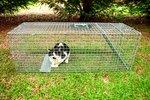Havahart traps are a safe and humane method of live trapping pets and wild animals. The traps are especially effective for trapping feral cats and kittens. The traps allow safe handling of animals with aggression and violent reactions to containment. Capturing and relocating feral cats is a common use of the Havahart trap but they are also effective for rabbits, rodents, weasels, squirrels, skunks and raccoon.
Trap Placement
Observe and learn about the travel routes of the animal you want to capture. Look for paw prints, feces, hair and any sign of the animal traveling through and occupying an area. Many animals utilize regular routes that follow walls and safe paths. Look for an area along one of the routes and follow it until you find a narrow point that will funnel the animal to your trap. Place the trap on a level piece of ground in this area.
Disguising the Trap
Cover the trap with a cloth or natural leaves, sticks and debris. Leaving the trap exposed will work but blending into the environment is a good practice. The cover increases the comfort level as the animal enters the trap.
Setting and Baiting
Set the trap without any food incentive and leave it for several hours. To set, simply pull the lever back to lift the door. Check back throughout the day and night to monitor the trap. If the trap fails to capture the animal, drop a small amount of cat food inside the trap and continue checking at regular intervals.
Warnings
Do not leave the trap unattended for long periods of time. The trapped animal will experience stress along with hunger and dehydration.
Handling the Animal
Immediately check on the condition of animal in your trap. Look for signs of dehydration and provide water without placing your finger or hand inside the trap. Cover the trap with a cloth to calm the animal while moving the trap. Hold the trap by the handle and maintain a level position to prevent jarring. Carefully place the trap in a vehicle for transport.
Warnings
Wear gloves during the handling process and do not contact the animal with your bare skin. Feral animals may carry disease and react violently in close contact.
Dealing with Captured Animals
Before you trap the animal, consult a veterinarian or call your local animal services to determine the final step. Feral cats are often spayed or neutered before relocation. Wild animals require professional services to relocate and many cities and counties have specific rules regarding the capture and relocation process.
References
Writer Bio
Zach Lazzari is a Montana based freelance outdoor writer and photographer. You can follow his work at bustedoarlock.com.





